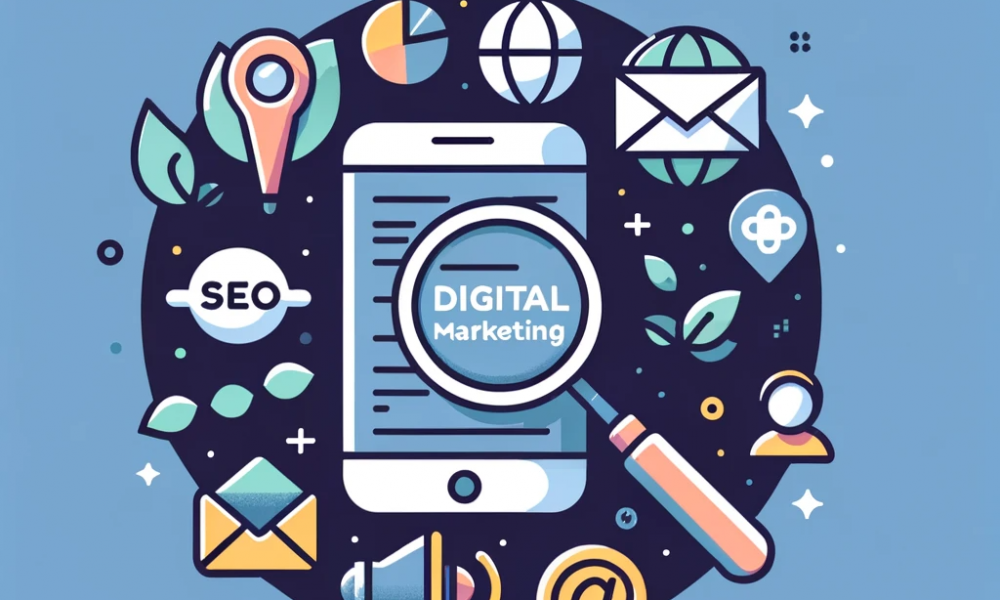
Understanding Digital Marketing: A Simple Guide for Everyone
Digital Marketing in Today’s World
In our digitally-driven world, digital marketing has become a key communication and promotion tool. It’s about reaching people through the platforms they use every day, like social media, search engines, and websites. Unlike traditional marketing, which relies on print ads or TV commercials, digital marketing is entirely online, encompassing various strategies to promote products and brands.
The significance of digital marketing is immense in an era where people spend a considerable amount of time online. It’s essential not just for businesses but for anyone interested in how digital trends influence consumer behavior. This modern marketing form is dynamic, evolving with technology and consumer habits.
Our journey through this article will simplify digital marketing. We’ll explore its different aspects – from SEO to social media marketing, from email campaigns to pay-per-click advertising – in an easy-to-understand manner. Whether you’re a business owner, marketer, or simply curious, this guide will help you grasp the essentials of digital marketing.
Let’s delve into this engaging world and understand how digital marketing shapes the way businesses connect with their audience.
The Basics of Digital Marketing
What is Digital Marketing?
Digital marketing involves promoting products or services through digital channels, using the internet and technologies like smartphones and computers. It’s about reaching consumers online, where they spend a significant amount of time.
Digital vs. Traditional Marketing
- Medium: Digital uses online platforms; traditional relies on print, broadcast, and direct mail.
- Engagement: Digital allows interactive, direct engagement, unlike traditional.
- Measurability: Digital campaigns are easily tracked and analyzed.
- Cost and Reach: Digital is often more cost-effective with a global reach.
- Customization: Digital marketing offers personalized communication based on online behavior.
Key Components
- SEO: Improving website visibility in search engine results.
- Content Marketing: Creating valuable content to engage audiences.
- Social Media Marketing: Promoting on social media platforms.
- Email Marketing: Sending personalized emails for promotions and updates.
- PPC Advertising: Ads where payment is made per click, like Google Ads.
Why Digital Marketing Matters
Reach: Expanding Audience Horizons
Digital marketing transcends geographical boundaries, allowing businesses to reach a global audience. Unlike traditional methods limited by location and medium, digital channels enable brands to connect with consumers across the world, regardless of their physical location. This expansive reach is crucial for businesses looking to expand their market, target diverse audiences, or explore new demographics.
Engagement: Interactive and Personalized Communication
One of the most significant advantages of digital marketing is the ability to engage with customers interactively. Through platforms like social media, forums, and blogs, businesses can interact directly with their audience, receive instant feedback, and foster a sense of community. This two-way communication is more personal and effective, allowing for real-time engagement and the building of stronger, more meaningful customer relationships.
Data and Analytics: Insight into Consumer Behavior
Digital marketing thrives on data and analytics, offering unparalleled insights into customer behavior and preferences. With tools like Google Analytics, businesses can track user interactions, understand consumer patterns, and make data-driven decisions. This ability to analyze and use data helps in refining marketing strategies, targeting the right audience, optimizing campaigns for better performance, and ultimately, achieving higher ROI. The importance of data in digital marketing lies in its precision and ability to tailor strategies to specific audience needs, making marketing efforts more efficient and effective.
Major Components of Digital Marketing
SEO (Search Engine Optimization)
Definition: SEO involves optimizing a website to improve its ranking in search engine results, making it more visible to potential customers.
Importance: High rankings in search results increase website visibility, leading to more organic traffic, higher credibility, and enhanced user experience. It’s a crucial component for businesses to ensure their online content is accessible and appealing to their target audience.
Content Marketing
Purpose: Content marketing focuses on creating and sharing valuable, relevant, and consistent content to attract and retain a clearly defined audience.
Impact: Quality content establishes brand authority, builds trust, and engages customers. It’s a strategic approach that nurtures customer relationships and encourages loyal, long-term engagement rather than short-term sales.
Social Media Marketing
Role: Social media marketing uses platforms like Facebook, Twitter, Instagram, and LinkedIn to promote products, services, and engage with audiences.
Benefits: It allows for direct customer interaction, brand personality showcase, and immediate feedback. It’s essential for building brand awareness, driving traffic, and fostering community around a brand.
Email Marketing
Strategy: Email marketing involves sending personalized, targeted messages to a group of people via email, often used for promotions, updates, and customer engagement.
Effectiveness: It’s a powerful tool for building relationships, offering high ROI, and allowing for precise targeting and personalization, making it a staple in digital marketing strategies.
Pay-Per-Click (PPC) Advertising
Basics: PPC is an online advertising model where advertisers pay each time a user clicks on one of their online ads.
Function: It drives traffic to websites quickly, complementing organic search efforts. Common platforms include Google Ads and social media ads. PPC is effective for reaching target audiences quickly and efficiently.
The Impact of Digital Marketing
Case Studies: Digital Marketing Success
- Fashion Brand: Leveraged Instagram influencers, resulting in a 50% sales increase in three months.
- Local Bakery: Used local SEO, boosting website traffic by 70% and increasing store visits.
- Online Education Platform: Employed targeted Facebook ads, doubling enrollments in six months.
These examples showcase the powerful results achievable through targeted digital marketing strategies.
Benefits for Small Businesses
Digital marketing offers small businesses:
- Cost-Effectiveness: More affordable than traditional methods, enabling competition with larger companies.
- Targeted Marketing: Precise targeting leads to more efficient use of marketing resources.
- Global Reach: Access to international markets without physical presence.
These advantages allow small businesses to effectively compete and grow.
Future Trends in Digital Marketing
Emerging trends include:
- AI and Automation: For personalized experiences and efficient marketing.
- Voice Search Optimization: Adapting to voice assistant usage.
- Interactive Content: Increasing engagement through interactive elements.
- Video Content: Maintaining its effectiveness in audience engagement.
- Data Privacy: Focus on ethical data use and consumer privacy.
These trends point towards a more personalized, interactive, and ethically-driven digital marketing future.
Getting Started with Digital Marketing
First Steps: Launching Your Digital Marketing Campaign
- Identify Your Goals: Determine what you want to achieve (increased sales, brand awareness, customer engagement, etc.).
- Understand Your Audience: Research and understand your target audience’s preferences and behaviors.
- Create a Content Strategy: Plan what type of content (blogs, videos, social media posts) will appeal to your audience.
- Set Up a Website: Ensure you have a user-friendly, mobile-responsive website as your digital home base.
- Optimize for SEO: Implement SEO best practices to improve visibility in search engine results.
- Engage on Social Media: Choose platforms where your audience is most active and start engaging with them.
Choosing Platforms: Selecting the Right Digital Channels
- Analyze Your Audience: Understand where your target audience spends their time online.
- Consider Your Product/Service: Some platforms are better suited for certain types of products or services.
- Test and Learn: Start with one or two platforms, test your approach, and adapt based on what works.
- Balance Trends and Fit: While it’s important to be where your audience is, also consider where your content fits best.
Measuring Success: Understanding Metrics and Analytics
- Traffic Metrics: Measure the number of visitors to your website and where they come from.
- Engagement Metrics: Track likes, shares, comments, and time spent on your content.
- Conversion Metrics: Monitor actions like sign-ups, purchases, or downloads that result from your marketing efforts.
- ROI: Calculate the return on investment to understand the profitability of your campaigns.
Analytics tools like Google Analytics can provide these insights, helping to refine and improve your digital marketing strategy.
Conclusion: Embracing the Digital Marketing World
In our exploration of digital marketing, we’ve highlighted its critical role in the modern business landscape:
- Reaching and Engaging Audiences: Surpassing traditional methods with interactive, targeted, and measurable strategies.
- Key Components:
- SEO: For online visibility.
- Content Marketing: To attract and retain customers.
- Social Media: For brand awareness and engagement.
- Email Marketing: For personalized communication.
- PPC: For immediate traffic and visibility.
Digital marketing is essential for businesses, especially small ones, offering global opportunities at a lower cost. As it evolves with new trends like AI and voice search optimization, understanding your audience and measuring success becomes more vital.
This field is not just a series of tactics but a crucial aspect of success in the digital age. We encourage you to dive into digital marketing, experiment, and grow. Your questions and feedback are welcomed as they enrich our shared journey in this dynamic landscape.
FAQs: Frequently Asked Questions
- Q1: What is the difference between SEO and PPC?
- A1: SEO focuses on improving organic search rankings, while PPC involves paying for each click on an advertisement.
- Q2: How often should I post content on social media?
- A2: It depends on your audience and platform, but consistency is key.
- Q3: Can small businesses compete with large companies in digital marketing?
- A3: Yes, digital marketing offers cost-effective strategies that level the playing field.
- Q4: How do I measure the success of my digital marketing efforts?
- A4: Use metrics like traffic, engagement, conversions, and ROI.
Glossary: Key Digital Marketing Terms
- SEO (Search Engine Optimization): Techniques used to increase a website’s visibility in search engine results.
- Content Marketing: Creating and sharing valuable content to attract and retain a specific audience.
- Social Media Marketing: Using social media platforms to promote products or services.
- Email Marketing: Sending targeted emails to a group of people for promotions or updates.
- PPC (Pay-Per-Click): An advertising model where payment is made each time an ad is clicked.
- ROI (Return on Investment): A measure of the profitability of a marketing campaign.
Related Blogs

A Comprehensive Guide to the Technology Industry: Sectors,.
Introduction The technology industry is experiencing incredible growth, and it’s easy to feel like you’re missing out on the.

Machine Learning: How to Start a Career and.
Are you interested in starting a career in machine learning? In today’s world, artificial intelligence (AI) is becoming increasingly.
